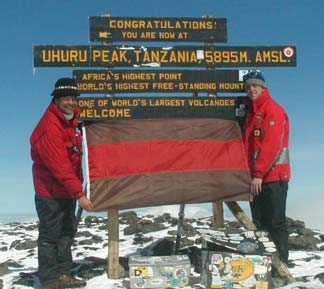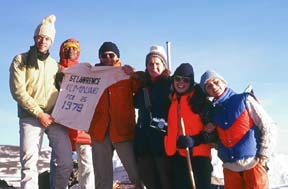Back in East Africa
By Dekkers L. Davidson ’78
 "We’re
over Africa…you can see the coast of Tunisia.” Indeed,
under the moonlit sky, I could see the silhouette of North
Africa against the Mediterranean Sea some 30,000 feet below
our Nairobi-bound plane.
"We’re
over Africa…you can see the coast of Tunisia.” Indeed,
under the moonlit sky, I could see the silhouette of North
Africa against the Mediterranean Sea some 30,000 feet below
our Nairobi-bound plane.
The words of excitement and anticipation could have been mine;
instead they were those of my son, Kyle ’06. He was heading
to the spring 2004 Kenya Program (KSP); his experience in Africa
was just beginning. That was where I had finished my St. Law-rence
education as a senior—an extraordinary semester in a
place I’d never forgotten.
That experience was coming back into sharp focus as we approached
our landing, and there was one we hoped to re-create together—the
climb to Kilimanjaro’s summit, which I had accomplished
as a student on the program in 1978. We and the mountain would
have a short visit together before the semester would begin
and I would return home.
A Different Nairobi. While I expected things would be different,
I wasn’t fully prepared to see how much Nairobi had changed.
The city sprawled in all directions and skyscrapers loomed
where parks and homes had stood 26 years before. Traffic overwhelmed
the same road system that had existed in the 1970s; cars, buses
and matutus (small trucks that pack a dozen or more into their
small cabs) crawled through the city at all hours of the day.
 |
| At Gilman's Point in 1978,
the St. Lawrence group includes, from left, Dekkers
Davidson '78, their guide, Peter Crossan '78, Joan
Flagg '79, Kathy Brown '79 and Kathy Flynn '79. |
Evidence of a new and tragic development, AIDs, was everywhere—perhaps
most poignantly in the buses marked by signs indicating they
carried AIDs victims or orphans. It seemed profoundly unfair
that a continent that has had so little had been further battered
by such a horrible disease. And yet, people smiled, laughed
and shouted amid the bustle—signs of life were everywhere
despite the chaos, confusion and hardship.
The former KSP compound in Westlands, now guarded by a large
concrete wall, had become a dilapidated apartment; the St.
Lawrence campus had moved years ago to a quiet and beautiful
site on Nairobi’s outskirts in the town of Karen, located
in the Ngong foothills. But some things seemed unchanged: the
favorite student hangout at the Norfolk Hotel near the University
of Nairobi seemed as it was years ago, as did the city market
where the merchants hustled us with the same “special
for you” deals that had made us laugh as students.
My African Family. My family home stay had been a very special
highlight of my experience; I’d lived just outside Nairobi
with the Mwakazi family. We’d remained in regular contact
by mail and e-mail; our reunion at their Langata home had been
a long time in the making. Reuben, who was then a playful 5-year-old,
was now a grown man with a career in the lumber business. Grace,
who had graduated from St. Lawrence in 1990, was married with
a son. And Mama Mwakazi was still the same happy and lovely
person I had always remembered. But sadly, Johnson, my home
stay father, was gone, having passed away suddenly in 1993—the
same month in which I had lost my father.
Africa’s Enduring Treasure. In 1978, our trip to Ngorongoro
Crater had been blocked at the border by tourist squabbles
between Kenya and Tanzania. But this time, nothing, not even
a tedious six-hour ride on a bumpy dirt road, would prevent
us from visiting this wildlife sanctuary on the Serengeti Plain.
Ngorongoro is a treasure chest of Africa’s most impressive
wildlife: elephants, lions, rhinos, gazelles, wildebeest, cheetah,
hippos, flamingos were everywhere inside this extraordinary
15-mile-wide crater. Nearby Lake Manyara showcased huge herds
of giraffe and elephant; at one point, nearly 100 elephants
lumbered by our vehicle, hardly giving us a nod. It was reassuring
to see so much wildlife and to know the game had been protected – something
that had been in doubt in the 1970s.
From the Equator to the North Pole. The highlight of our short
trip would be the long climb to Kilimanjaro’s summit,
which stands at 19,350 feet above sea level, looming over the
plains of East Africa. I’d made the trek with five classmates,
reaching the summit on February 28, 1978—it had seemed
so easy. As we’d done then, Kyle and I based our expedition
at the Kibo Hotel and were provided two experienced mountain
guides and a crew for the five-day, 70-mile trek.
The climb, sometimes called the “shortest walk from
the Equator to the North Pole,” would take us through
nearly every climactic zone on Earth. We’d start in mountain
meadows, climb through rain forests, trek above the tree line
across barren desert, and ascend on volcanic scree before reaching
the summit. Our January climb would be in the “dry season,” and
good weather was expected. Instead, rain, hail and snow fell
on each day but the first (the exact opposite to the weather
during our earlier climb). Nevertheless, we had done enough
hiking and climbing to deal with the conditions and made camp
each night without much difficulty. And we had enough good
visibility between the storms to see the imposing summit above—so
we could see what lay ahead.
Or so we thought. The final ascent of Kiliminjaro began around
midnight with the goal of being on the summit by sunrise. But
on this moonless night, the zero-degree temperature and thin
air turned our strides into a slow shuffle. The cold had been
expected, yet we were surprised to find our water bottles partially
frozen, discouraging us from drinking as much as we needed.
The guide’s hot chocolate held far more appeal, though
it did not provide much hydration. Kyle, just recovering from
a broken leg suffered in a rugby match a few months earlier,
needed my encouragement to keep going; the cold bothered his
legs and toes.
Our spirits soared with the arrival of the warm sunrise just
as we reached Gilman’s Point—the rim of Kilimanjaro’s
long-dormant volcano. With a clear blue sky, we could see Uhuru
Peak a couple of miles away—it was, we thought, easily
within reach. On my previous climb, we’d been shrouded
in snow and I had followed my guide blindly and rapidly to
the summit. From memory, I was certain it was just a 30- to
45-minute walk.
But the final climb, now under a hot sun, took a long and
tedious two-plus hours. When we reached Uhuru Peak we were
totally spent, and it was still only 9 a.m. But the snow that
I remembered was gone. Deforestation at the foot of the mountain
has been blamed as much as global warming. The top of Africa
had clearly changed, and some predict that the snow-covered
glaciers just below the summit may disappear entirely in another
25 years. (For more on this, see the story on page 44, on the
research being conducted by Doug Hardy ’79.) We took
a few pictures, used our satellite phone to call home to declare
our success (something unimaginable in 1978!), and began our
descent—just as a blinding snowstorm arrived. To make
matters worse, I’d become light-headed and dizzy—I
could not believe I was experiencing altitude sickness on our
descent. I suddenly realized I’d not drunk enough water.
As quickly and carefully as possible, we worked our way down
the mountain, mindful that most climbing injuries occur on
the more dangerous descent. And now it was Kyle’s turn
to help: he forced me to drink water and, along with the guides,
helped me descend. We found refuge at 17,000 feet in the Hans
Meyer Cave as the snow turned to hail and cold rain. By noon,
12 hours after our summit push began, we were back at our final
base camp and had changed into dry clothing and finally warmed
up.
The next day, under a deluge of rain, we finally made it back
to the Kibo Hotel and celebrated with our guides and crew.
We had followed the same itinerary as I had used in 1978, but
the experience had been a very different one—the weather
had humbled us and the changes to the summit had left a lasting
impression. But, it had been a thrill to raise the
St. Lawrence flag atop Kilimanjaro and to have shared this
experience with my son.
When we said our goodbyes, Josef, our assistant guide, told
us that his earnings from our trek would allow him to pay for
his child’s education for an entire year….reminding
us that small things can make a big difference in East Africa.
It was a lesson I remembered from years ago, and one that Kyle
would see borne out many times in the months ahead.
For a second time for me, and for Kyle, a second-generation
KSP participant, there had been an unforgettable experience
in East Africa.
St. Lawrence Trustee Dekkers Davidson lives and operates
a business in Concord , Mass.

